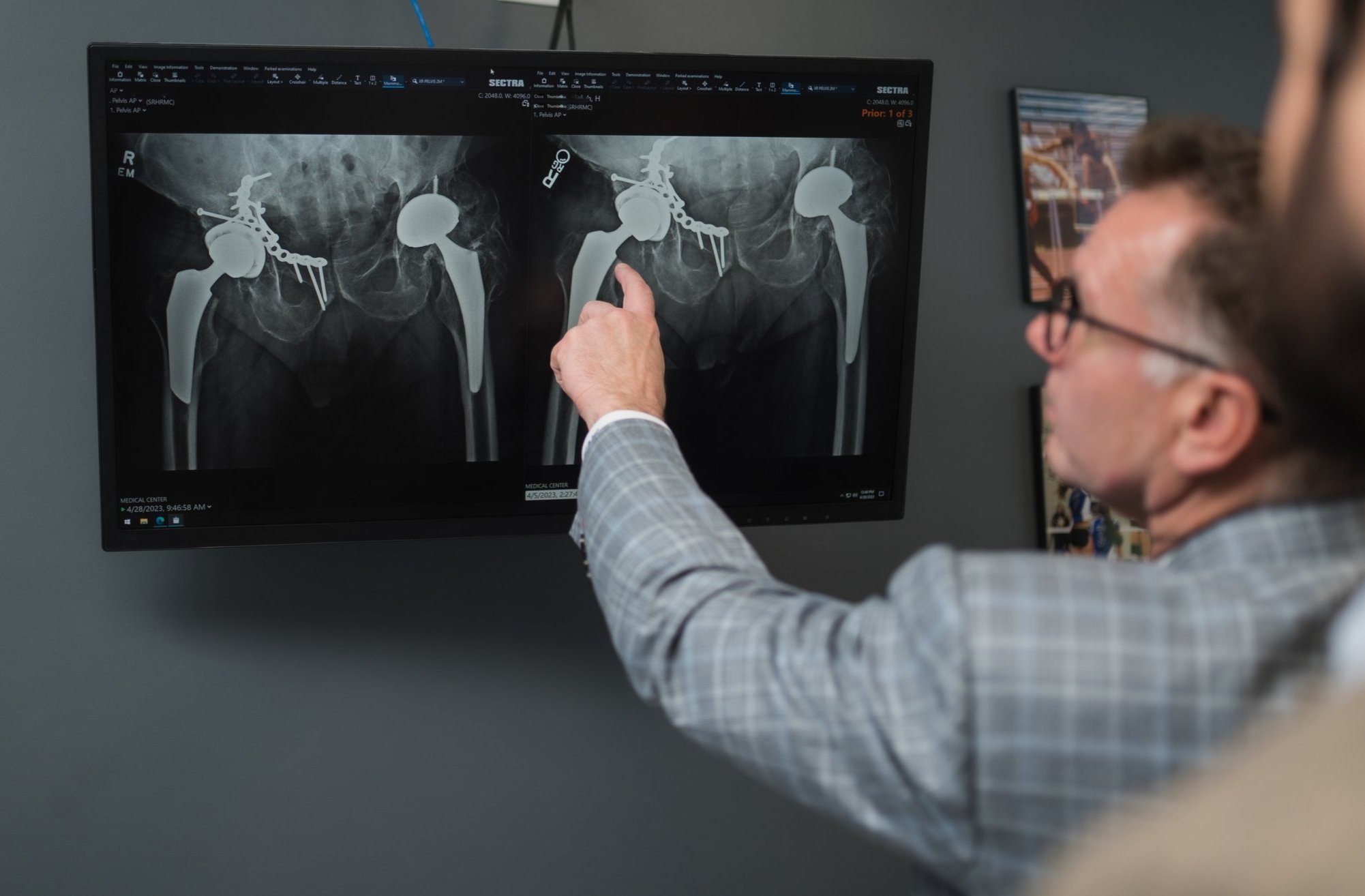
Hip replacement in san antonio
Hip Anatomy and Why Hip Pain Develops
The hip joint is one of the largest and strongest joints in the body. It is formed where the rounded head of the thighbone (femur) fits into a deep, cup-shaped socket called the acetabulum, located in the pelvis. This ball-and-socket structure allows for a wide range of motion, including walking, running, and bending.
To ensure smooth and painless movement, the surfaces of the femoral head and acetabulum are covered with a slippery, white tissue called articular cartilage. This cartilage reduces friction and absorbs shock during activities.
Strong bands of tissue called ligaments connect the femur to the pelvis, providing stability to the joint. Surrounding muscles, such as the gluteal and hip flexor groups, are attached to the bones by tendons, working together to support movement and maintain balance. The entire joint is enclosed in a fibrous capsule, which is lined by a synovial membrane. This membrane produces synovial fluid, which lubricates the joint and helps keep the hip functioning smoothly.
What is A Hip Replacement (Arthroscopy)?
Arthroscopy, also referred to as keyhole or minimally invasive surgery, is a procedure in which an orthopedic surgeon inserts and arthroscope into a joint to check for any damage and repair it simultaneously.
An arthroscope is a small, fiber-optic instrument consisting of a lens, light source, and video camera. The camera projects an image of the inside of the joint onto a large screen monitor allowing the surgeon to look for any damage, assess the type of injury, and repair the problem.
Why is Ortho San Antonio the best place for your Hip Replacement?
The providers at Ortho San Antonio have provided over 160 years of combined experience. Our practice consists of board certified orthopedic surgeons, sports medicine physicians, & physical therapists to ensure we are with you every step of the way.
Our goal is to get you back to what you enjoy, safely. We have over seven locations across San Antonio to Boerne.
Types of Hip Replacements Ortho SA Specializes in
Total Hip Replacement (THR): Also known as Total Hip Arthroplasty, this is the most common type of hip replacement.
What It Is: The damaged bone and cartilage are removed and replaced with artificial components, including a metal stem inserted into the femur, a ceramic or metal ball replacing the femoral head, and a cup placed into the hip socket (acetabulum).
Ideal For: Patients with advanced osteoarthritis, rheumatoid arthritis, hip fractures, or severe joint damage affecting the entire hip.
Partial Hip Replacement (Hemiarthroplasty): A procedure that replaces only the femoral head, not the socket.
What It Is: The damaged femoral head is removed and replaced with a prosthetic ball, while the natural socket is left intact.
Ideal For: Patients with certain types of hip fractures, especially in elderly patients, where the socket remains healthy.
Robotic-Assisted Hip Replacement: A technology-enhanced approach for greater precision and personalized outcomes.
What It Is: Surgeons use advanced robotic systems to create a 3D model of your hip, allowing for highly accurate planning and placement of the implant. During surgery, the robotic arm assists in guiding the surgeon's movements, ensuring optimal alignment and balance.
Ideal For: Patients who are candidates for total hip replacement and want a customized, data-driven approach that may reduce complications, improve joint function, and speed up recovery.
Hip Resurfacing: An alternative to total replacement, typically for younger, more active patients.
What It Is: Instead of removing the femoral head, the bone is trimmed and capped with a smooth metal covering. A metal cup is placed in the socket.
Ideal For: Younger, active patients with strong bone quality who want to preserve more natural bone.
Revision Hip Replacement: A more complex procedure to repair or replace a previous hip implant.
What It Is: Removal of the old prosthetic components and replacement with new implants, often needed after wear, infection, dislocation, or mechanical failure.
Ideal For: Patients who have had a previous hip replacement that has failed over time.

Living with Hip pain is hard. Let’s Find a solution to your pain.
Here at Ortho SA, our team of board-certified surgeons treats the source of your pain and finds the best treatment available to ensure the best possible outcome.
Meet our Hip replacement surgeons
-

Dr. Matthew Morrey
-

Dr. Travis Burns
-

Dr. John Hinchey
-

DR. Cody Covington
-

Dr. Alan Hibberd
What are the signs and Indications that you should get a Hip Replacement?
Hip replacement (arthroscopy) is a surgical procedure performed through very small incisions to diagnose and treat various hip conditions including:
Removal of torn cartilage or bone chips that cause hip pain and immobility
Repair a torn labrum (fibrous cartilage ring that lines the acetabular socket)
Removal of bone spurs or extra bone growths caused by arthritis or an injury.
Removal of part of the inflamed synovium (lining of the joint) in patients with inflammatory arthritis (partial synovectomy)
Repair of fractures or torn ligaments caused by trauma
Evaluation and diagnosis of conditions with unexplained pain, swelling, or stiffness in the hip that does not respond to conservative treatment
What occurs during the Hip replacement procedure?
Hip arthroscopy is performed under regional or general anesthesia depending on you and your orthopedic surgeon’s preference.
Your surgeon will make 2 or 3 small incisions about 1/4 inch in length around the hip joint. Through one of the incisions an arthroscope is inserted. Along with it, a sterile solution is pumped into the joint to expand the joint area and create room for the surgeon to work.
The larger image on the television monitor allows the surgeon to visualize the joint directly to determine the extent of damage so that it can be surgically treated. Surgical instruments will be inserted through other tiny incisions to treat the problem. After the surgery, the incisions are closed and covered with a bandage.
How do i care for myself post-Hip replacement surgery?
Recovering from hip replacement surgery takes time, care, and the right support. To manage pain and protect your new joint, your orthopedic surgeon will likely recommend using crutches or a walker for the first few weeks. Following your medication schedule carefully can help keep discomfort under control and make it easier to stay active during recovery.
Physical therapy will be a crucial part of your healing process. Gentle exercises help rebuild strength, improve flexibility, and restore normal movement. Along with staying active, maintaining a healthy diet and avoiding smoking can speed up your body’s natural healing.
During the early stages of recovery, it’s important to avoid lifting heavy objects or doing strenuous activities. Giving your hip time to heal properly can help you return to daily life faster and with better long-term results.
What are some Risks and Complications of Hip Arthroscopy?
As with any surgery, hip arthroscopy comes with some risks. Infection can develop at the incision site or inside the joint. There’s also a chance of nerve damage, which may cause numbness, tingling, or weakness. Some patients experience bleeding into the joint (hemarthrosis), leading to swelling and discomfort.
Our Locations
-

Alamo Heights
Address: 423 Treeline Park, Suite 350, San Antonio, TX 78209
-

Westover Hills
Address: 11212 State Highway 151, Medical Plaza 1, 2nd Floor, Suite 200, San Antonio, TX 78251
-

Medical Center
ADDRESS: 2833 Babcock Rd, Tower 2, Suite 435, San Antonio, TX 78229
-

Boerne
ADDRESS: 138 Old San Antonio Rd, Suite 302, Boerne, TX 78006
-

Castroville
Address: 346 County Road 4712, Castroville, TX 78009
-

Piedras
ADDRESS: 4100 E. Piedras, Suite 165, San Antonio, TX 78228
-

Schertz
Address: 6051 FM 3009, Suite 260, Schertz, TX 78154


